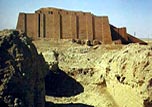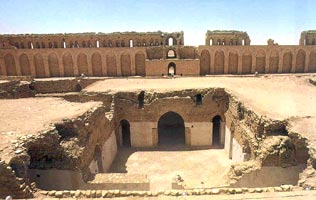 New Page 1
New Page 1
|
Tour in the South
Historical Sites
Babylon:
Babylon lies 90 kms south of Baghdad, some 10 kms north
of Hilla. The road to Babylon branches off the main Baghdad-Hilla
highway. A legendary city in ancient history Babylon figures prominently
in the Bible as well as in the writings of travelers and historians for
its wealth and magnificence. Its walls and hanging gardens were one of
the seven wonders of the ancient world. In Akkadian times, around 2350
B.C., Babylon was a small village which five or six centuries had grown
the size and importance, mostly during the reign of the Third dynasty,
until it became the capital of the famous king, law-giver and social
reformer Hammurabi ( 1792-1750 B.C.). In the next thousand years or so
it witnessed the growth of other Mesopotamian cities which surpassed it
in power and influence until, in the 2nd Chaldean Kingdom (625-538
B.C.), it flourished again as the capital of a mighty and prosperous
country. King Nebuchadnezzar (605-563 B.C.) rebuilt it in accordance
with a new plan that took especial care of its fortifications, and
Babylon thus became the largest and loveliest city of its time.
Borsippa:
When you leave Babylon for Kufa you will see a long
distance away on the right the ruins of a unique city, 15 kms to the
south of Babylon; Borsippa, or Birs Nimrud. It had its own religious
significance as the place for the worship of Nabu, son of the great
Babylonian god Marduk. You can still see the 47 meter high structure
which was once its seven-level ziggorat. If you climb it, you will
wonder what those dark-green lumps of molten bricks are. Some scholars
believe that the tower was one day hit by a comet which melted its
bricks.
-
Ukhaidher Castle
 Castle or Palace, Ukaidher is certainly one of
the greatest monuments of early Islam you can see in this area. It was
built by the Arabs with stone and plaster on a plan which suggests the
high skill of its architects in the use of vaults and arches. Most
scholars believe that it goes back to the eighth century – that is, the
beginning of the Abbasid age. 50 kms, away to the South-west of Kerbala,
this has always been the most prominent structure on the way between
Iraq and the upper Euphrates and Syria. A fortified wall runs round the
palace, exactly like a warlike castle. Its rectangular measurements are
175.8 x 163.6 meters, with a height of nearly 21 meters. In the middle of
each side there is a large tower which also acts an entrance to the
castle. The inner residential part is at some distance from the wall,
except on the northern side. An annex was added to the middle of the
eastern wall, and another front of the western wall. The main parts are
a guards room, reception halls, dwelling apartments, a mosque and a
bath. All these are gathered in one rectangular combine measuring 112 x
80 meters. Castle or Palace, Ukaidher is certainly one of
the greatest monuments of early Islam you can see in this area. It was
built by the Arabs with stone and plaster on a plan which suggests the
high skill of its architects in the use of vaults and arches. Most
scholars believe that it goes back to the eighth century – that is, the
beginning of the Abbasid age. 50 kms, away to the South-west of Kerbala,
this has always been the most prominent structure on the way between
Iraq and the upper Euphrates and Syria. A fortified wall runs round the
palace, exactly like a warlike castle. Its rectangular measurements are
175.8 x 163.6 meters, with a height of nearly 21 meters. In the middle of
each side there is a large tower which also acts an entrance to the
castle. The inner residential part is at some distance from the wall,
except on the northern side. An annex was added to the middle of the
eastern wall, and another front of the western wall. The main parts are
a guards room, reception halls, dwelling apartments, a mosque and a
bath. All these are gathered in one rectangular combine measuring 112 x
80 meters.
-
Ain Al-Tamr
Not very far away are the remains of the historical
city of Ain Al-Tamt (Shuthatha). Although its first settlements date
back to the pre-Christian era, it flourished in the 2nd and 3rd
centuries of our era, and acquired particular importance after the Arab
conquest when it became a major military and trade center and was the
birthplace of a number of famous men, notably Musa Ibn Nusair, the Arab
leader who conquered Spain and became the ruler of Seville. Today Ain
Al-Tamr is the largest oasis in the western plateau, famed for its palm
groves and fruit orchards and lovely scenery. Its pleasant climate in
spring and autumn, together with its mineral waters (from no less that
50 natural springs), makes it a very attractive spot to visitors. A rest
house a restaurant and a number of chalets have been built in the area.
-
Nippur
It lies 35 kms, to the north-east of Diwaniya, 180 kms to the
south-west of Baghdad. Nippur has yielded us a large number of
antiquities that span the Summerian and Babylonian periods, up to
Abbasid times. It was a large city neatly divided by old Euphrates. On
the east was the temple area, which held the ziggurat and the temple of
Inlil, god of the wind and creator of the universe. Outside its walls is
the ‘tell of tablets’ where excavators have dug up an enormous number of
tablets containing all kinds of knowledge. The square ziggurat, 15
meters high, had probably several levels with three stair-cases, like
other Mesopotamian ziggurats, all built of mud-bricks enveloped with
hard bricks. It dates back to the time of king Ur-Nammu.
-
Uruk (Warka)
One of the most famous Summarian cities of ancient
Iraq. It was continuously inhabited from about 400 B.C. up to the 5th
century A.D. Because of the part it played in Iraqi culture for such a
long time you may want to spend some time among its ruins. Uruk lies
about 30 kms. To the east of Samawa, and in the past it used to be on
the Euphrates before it changed its course so much that it nearly 12 kms,
away. It was an important city on two scores: religion and science,
which is confirmed by the thousands of clay tablets dug up in it which
go back to the beginning of writing – about 5000 years ago – in the
invention of which Uruk played a major role. It was also the center of
the worship of Goddess Inanna, or Ishtar, which is symbolized by the
star Venus. Her worship went to the Greeks and Romans under the name of
Aphrodite of Venus, who had exactly the same attributes as Ishtar. Uruk
was renowned for iuts walls which cuneiform texts say were first built
4700 years ago by the Summerian King Gilgamish, hero of the epic named
after him. The city limits and traces of its round walls are visible
today. The latter are about 9.5 kms long. Among major remains is the
ziggurat of Inanna – Ishtar which rises to a hight of 16 meters on a
square base measuring 60 x 60 meters. It dates back to the time of Ur-
Nammu, 4000 years ago. In its neighborhood are the ruins of a temple
which used for mural ornamentation thousands of colored clay cones.
Another temple in ruins is the one devoted to Anu, god of the sky, built
with mud brick some 5000 years ago. Nearby is another temple devoted to
Anu and his wife Anu- Antim, but it is a comparatively recent structure:
it was built in Seleucid times, about 2,200 years ago. An even more
recent structure is the brick temple whose façade is ornamented with
arches and columns, together with decorative brickwork of animals and
geometrical patterns. It was built around A.D.110.
-
The City of Ur
Excavations have proved that Ur was leading among
the old Sumerian cities of Mesopotamia. Its earliest dwellings go back
some six thousand years, and after it had enjoyed prominence in the dawn
of dynasties, 4800 – 4300 years ago, it assumed a leading position
during the Third dynasty of Ur, over 4000 years ago. In later times,
although political leadership shifted to other Babylonian and Assyrian
centers, it maintained its importance and kings continued to lavish
their care on its temples and institutions. The landmark of the city lie
within a large area the inhabited section of which measured 1200 x 700
meters. It was encircled by a mud-brick wall, almost elliptical in
shape. The most important structure was the holy pyramid which contained
all the major temples together with the magnificent 3-level ziggurat
built by Ur-Nammu, FOUNDER OF THE THIRD DYNASTY OF Ur 92124 – 2107 B.C.)
The lower level measuring 62.5 x 43 meters, the third, 20 x 11 meters.
The whole structure was 17.25 meters high. To the east of the temple
area is a huge pit which was a vast cemetery dating back to the third
dawn of dynasties, 4500 years ago. It contained about two thousand
graves which have yielded a veritable treasure of rare objects that have
enriched the display halls of many museums, such as the Iraq museum, the
Nasiriya museum, the British, and Pennsylvania museums. The objects
range from musical instruments (e.g. the Lyre of Ur) to gold and silver
ornaments and precious jewelry. Next to it is the cemetery of the kings
and princes of the third dynasty of Ur. It s special feature is its
sloping roofs. Not far away one can roam at leisure in a once-inhabited
quarter that dates back to the old Babylonian era.
|


